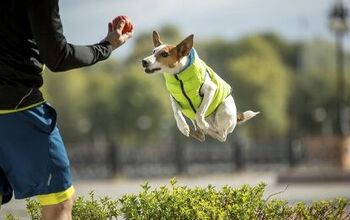Are Dogs Colorblind?

Humans and dogs experience the world in very different ways. As a human, you have the ability to make decisions based on past experiences and with forethought of the future. As a dog, you live in the moment and the future is unknown.
Dogs and humans are not just different in the ways they experience the world, but also in the ways they see it. Humans can perceive a wide range of colors while a dog’s vision is much more limited in terms of color. But are dogs actually colorblind? Keep reading to find out.
Related: Muffin’s Halo Is A Fashionable Guide For Blind Dogs
Do Dogs Only See in Black and White?
It is a common myth that dogs only see in black and white. Not only is this untrue but seeing only in black and white is only one form of colorblindness. Contrary to popular belief, dogs are actually capable of seeing color, though it is a much more limited range than you are able to see. Color vision is supported by specialized photoreceptor cells in the retina called cones. When these cones are stimulated, they transmit signals to the brain which is translated into the perception of color. The human eye contains three types of cones while a dog’s eye only has two, hence the difference in the range of perceivable colors.
Related: Living Well With Your Blind Dog
So, what colors are dogs actually capable of seeing?
A dog’s color vision consists primarily of blues, yellows, and violet hues. A dog cannot distinguish reds, greens, or oranges – they appear somewhere along the yellow-to-blue spectrum in a dog’s vision. Even though your dog can’t tell the difference between red and orange in the same way that you can, his ability to see detail and to see clearly in the dark is much stronger than yours. While dogs only have two types of cones in their retinas, they have more rods which results in stronger night vision and an improved ability to track movement.
What Else Should You Know About Your Dog’s Vision?
While your dog’s ability to distinguish different colors may not be as strong as yours, his vision is better than yours in other ways. Having fewer cones in their retinas means that dogs are not as good at interpreting color or brightness as humans – their strength lies in low-light or night vision. A dog’s retina has a higher concentration of rod cells which function better in low lighting to interpret motion.
So, while your dog may not see objects as clearly as you, his ability to track motion is much stronger. If you add to that your dog’s sense of smell which is 50 times stronger than yours, it’s plain to see that your dog isn’t suffering for his lack of color vision. In fact, dogs are much better than humans at using all of their senses together.
Because your dog can’t speak up and tell you when something is wrong with his vision, you need to keep an eye out for signs of a problem. If your dog starts bumping into objects, becomes nervous about moving around at night, or if his eyes start to become cloudy, it could be time for an eye exam.

Kate Barrington is the loving owner of two cats (Bagel and Munchkin) and a noisy herd of guinea pigs. Having grown up with golden retrievers, Kate has a great deal of experience with dogs but labels herself a lover of all pets. Having received a Bachelor's degree in English, Kate has combined her love for pets and her passion for writing to create her own freelance writing business, specializing in the pet niche.
More by Kate Barrington























